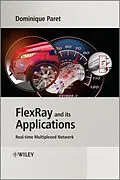An authoritative yet highly accessible guide to the design and
operation of the FlexRay bus, the latest protocol for automotive
network communications
A translation of the French edition, originally published in
January 2011, this work is the result of numerous training courses
that Dominique Paret has given in companies, and it provides
detailed explanations of the design and operation of the FlexRay
bus. Comprised of five parts the book covers: the FlexRay concept
and its communication protocol; the FlexRay physical layer;
synchronization and global time and; architecture of a node,
components and development aid tools for hardware and software.
* Provides comprehensive treatment of the FlexRay network,
including its implementation through a real automotive
application
* Includes the latest specifications (Version 3) concluded by the
FlexRay consortium widely expected to become the industry
standard
* Written by an author with in-depth experience of automotive
electronics, including FlexRay, and presenter of specialist
training courses to the industry
* Includes a review of industrial tools to help design and
implement a FlexRay based distributor application
Autorentext
Dominique Paret, dp-Consulting, Paris, France Mr Paret worked at Philips for 15 years on automotive electronics projects including CAN (Controller Area Network), LIN (Local Interconnect Network), very high speed buses, time triggered concept FlexRay, Safe by Wire, SBC (Single-board Computer), fail safe systems as well as identification, including smart cards, and RFID (radio frequency identification). He has also represented Philips in several standardization organizations such as the French National Body (AFNOR), ISO (International Organization for Standardization) working groups for radio frequency identification and other consortiums for electronic automotive standards. In addition to this, he lectures for several technical schools in France and Pretoria, South Africa, and is an experienced author, having written a number of books. Now he offers training and consultancy to the automotive industry.
Zusammenfassung
An authoritative yet highly accessible guide to the design and operation of the FlexRay bus, the latest protocol for automotive network communications
A translation of the French edition, originally published in January 2011, this work is the result of numerous training courses that Dominique Paret has given in companies, and it provides detailed explanations of the design and operation of the FlexRay bus. Comprised of five parts the book covers: the FlexRay concept and its communication protocol; the FlexRay physical layer; synchronization and global time and; architecture of a node, components and development aid tools for hardware and software.
- Provides comprehensive treatment of the FlexRay network, including its implementation through a real automotive application
- Includes the latest specifications (Version 3) concluded by the FlexRay consortium widely expected to become the industry standard
- Written by an author with in-depth experience of automotive electronics, including FlexRay, and presenter of specialist training courses to the industry
- Includes a review of industrial tools to help design and implement a FlexRay based distributor application
Inhalt
Preface xiii
List of Abbreviations xvii
Part A 'SECURE REAL TIME' APPLICATIONS
1 Reminders about the CAN Protocol 3
1.1 The Limitations of CAN 3
1.2 'Event-Triggered' and 'Time-Triggered' Aspects 4
2 The TTCAN Protocol 7
2.1 TTCAN ISO 11898-4 7
2.2 Session Layer 8
2.3 Principle of Operation of TTCAN 8
3 Emergence of 'X-by-Wire' Systems 11
3.1 High Throughput and X-by-Wire 11
3.2 Redundancy 11
3.3 High-Level Application Requirements 13
3.4 High-Level Functional Requirements 14
Part B THE FLEXRAY CONCEPT AND ITS COMMUNICATION PROTOCOL
4 The Genesis of FlexRay 19
4.1 The TTP/C Protocol 19
4.2 FlexRay 20
4.3 The FlexRay Consortium 20
4.4 The Aim of FlexRay 23
5 FlexRay and Real Time 29
5.1 Physical Time 29
5.2 Local Time 30
5.3 Global View at Network Level Global Time 32
5.4 Summarising: Time and its Hierarchies in FlexRay 36
6 The FlexRay Protocol 41
6.1 History 41
6.2 General Channels, Cycles, Segments and Slots 41
6.3 Channels and Cycles 44
6.4 Segments 47
6.5 Communication Frames 57
6.6 'SW Symbol Window' Segment 74
6.7 'NIT Network Idle Time' Segment 76
7 Access to the Physical Layer 77
7.1 Definition of Tasks 77
7.2 Execution of the Communication Cycle 80
7.3 Frame ID (11 Bits) 80
7.4 Arbitration Grid Level 81
7.5 Conditions of Transmission and Access to the Medium during the Static Segment 83
7.6 Conditions of Transmission and Access to the Medium during the Dynamic Segment 84
7.7 Similarity of the Use of the Dynamic Segment to the Network Access of the CAN Protocol 88
7.8 Some Additions in the Case of FlexRay Being Used with Two Channels 89
Appendices of Part B 91
Appendix B1 Examples of Applications 93
The BMW X5 (Development Code L6) 93
A Little Strategy 93
Global View of the Parameters of the FlexRay System 95
Desired Functional Parameters 96
Description and Justification of the Implemented Choice 97
Appendix B2 Scheduling Problems Application of the FlexRay Protocol to Static and Dynamic Segments 103
Introduction 103
Problems of 'Real Time' Systems 104
FlexRay 108
Scheduling Real Time Systems 109
Different Approaches to Real Time Scheduling 113
Scheduling in Single-Processor Systems 116
Algorithms Based on Priorities 116
Scheduling Communications in Distributed Systems 120
Problem of Task Allocation in a Distributed System 121
Scheduling Communications 121
Policy of Assigning Priorities 126
Class of Scheduling Problem 127
Scheduling Algorithm 128
Conclusion 129
Part C THE FLEXRAY PHYSICAL LAYER
8 Creation and Transmission (Tx) of the FlexRay Signal 135
8.1 Creation of the Signal 135
8.2 Physical Representation of Bits 136
8.3 Line Driver 'Tx' 138
9 Medium, Topology and Transport of the FlexRay Signal 143
9.1 Medium 143
9.2 Effects Linked to Propagation 146
9.3 Topologies and Consequences for Network Performance 147
9.4 Single-Channel, Dual-Channel and Multi-Channel Communication Topologies 151
9.5 The FlexRay Topologies 153
9.6 Examples of Topologies 159
10 Reception of the FlexRay Signal 165
10.1 Signal Reception Stage 165
10.2 Processing of the Received Signal by the Communication Controller 170
11 The Bit Error Rate (BER) 175
1...
